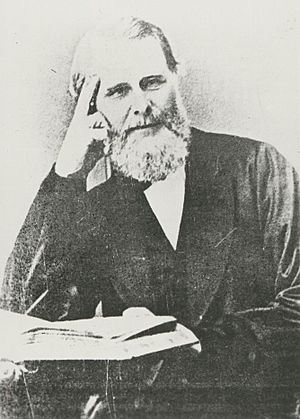Matthew Moorhouse facts for kids
Matthew Moorhouse (born in 1813 – died on March 29, 1876) was an important early settler in Australia. He was a farmer who raised animals and also a Protector of Aborigines in South Australia. This role meant he was supposed to look after the rights and well-being of Aboriginal people. Moorhouse was involved in a serious and tragic event known as the Rufus River massacre, where many Maraura people died.
Contents
Early Life and Coming to Australia
Matthew Moorhouse studied medicine and became a surgeon in 1836. He was working as a doctor in a town called Hanley, Staffordshire in England. On June 20, 1839, the government chose him to be the Protector of Aborigines for South Australia. He held this important job until 1856.
He arrived in South Australia in June 1839. He sailed on a ship called the Sir Charles Forbes.
Working as a Protector of Aborigines
The Piltawodli Mission
As the Protector, Matthew Moorhouse lived for some years at a place called Piltawodli. This was a mission and camp for Aboriginal people. He worked closely with German missionaries named Christian Teichelmann and Clamor Schürmann. These missionaries learned and taught in the Kaurna language, which is the language of the local Aboriginal people.
Moorhouse kept a diary, and one page of it still exists today. It contains some songlines (traditional songs) from the Kaurna people that are not found anywhere else. We also know a lot about the Kaurna people from his official reports and letters.
In July 1845, the whole Piltawodli site, including its school, was closed down. This happened because Governor George Grey ordered it. He believed it was better to move Aboriginal children to a new school.
The Native School
A new government-run school, called the "Native School," was then set up. This school taught only in English. It was located near what is now Kintore Avenue, Adelaide. The Aboriginal students at this new school were very bright and learned well. However, not many children attended.
In 1849, Moorhouse used the schoolhouse as a temporary home for Irish orphan girls who arrived in South Australia. The Native School closed in 1851. Its buildings later became part of the Adelaide Destitute Asylum, which was a place for people who needed help. The remaining Aboriginal children were moved to the Poonindie Mission near Port Lincoln.
The Rufus River Conflict
In 1841, a serious disagreement happened between European overlanders (people moving livestock) and the Maraura people. The Maraura were a group of the Barkindji people. Matthew Moorhouse led a group of armed settlers to the Rufus River, near Wentworth, New South Wales. This was after reports that about 150 Barkindji warriors seemed ready to attack.
A confrontation took place, and the settlers opened fire. Many Indigenous people died, and others were injured. Moorhouse's official report to the Governor of South Australia, George Grey, stated that nearly 30 Indigenous people died, about 10 were wounded, and four were taken prisoner. It is believed that most of the wounded would have died later, as Aboriginal medicine at the time was not equipped to treat gunshot wounds. This event is a very sad part of Australia's history.
A Career in Politics and Farming
In January 1855, Moorhouse took on more responsibilities. He became the manager of the Adelaide Destitute Asylum and the superintendent of the Female Immigrant Depot. He retired from his official roles on March 31, 1856.
After retiring, he traveled to England. There, he gave talks about South Australia and encouraged people to move there. He then visited North America, where he traveled a lot by train and studied different education systems.
Matthew Moorhouse also became a member of the South Australian House of Assembly. This is like being a politician in the state government. He represented the City of Adelaide from 1860 to 1862. For a short time in 1860 and 1861, he was also a commissioner for Crown lands and immigration in the government led by George Waterhouse.
Later Years
For several years, Matthew Moorhouse became a successful pastoralist (a large-scale farmer) in the northern part of South Australia. He only practiced medicine when there were emergencies. He bought parts of properties near Riverton and Saddleworth. Later, he sold these and, with others, bought a large area of land (about 27,700 acres) near the Hummocks. Moorhouse managed this farm until Robert Barr Smith bought it in 1870.
Matthew Moorhouse died after a short illness on his farm called Bartagunyah. This farm was near Melrose, South Australia. He passed away on March 29, 1876. He left behind his wife, two sons, and a daughter.
See Also
- Kaurna
- List of massacres of Indigenous Australians
- Henry Inman (police commander)
- James Rigby Beevor
- Maria (brigantine)
- James Brown (Australian pastoralist)


